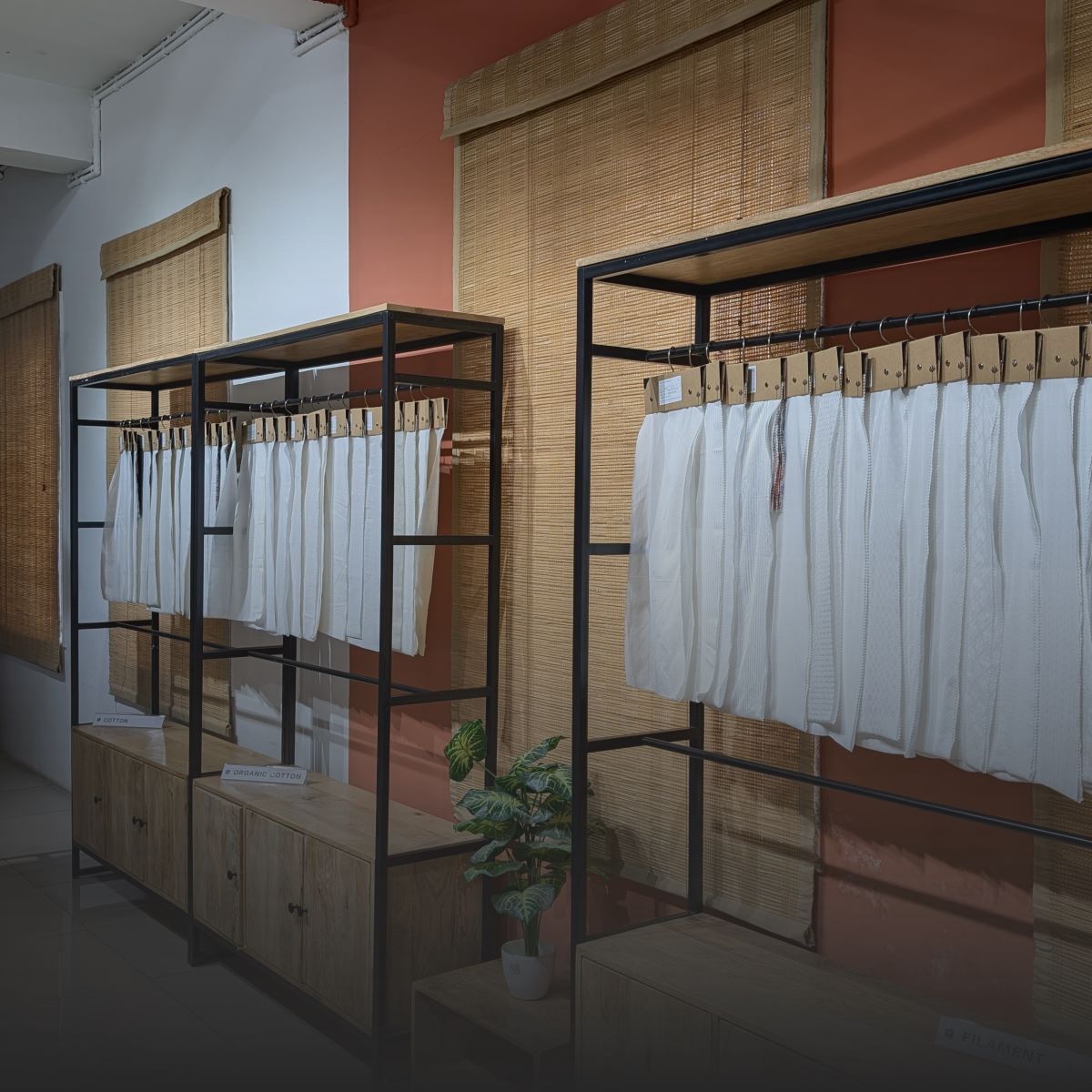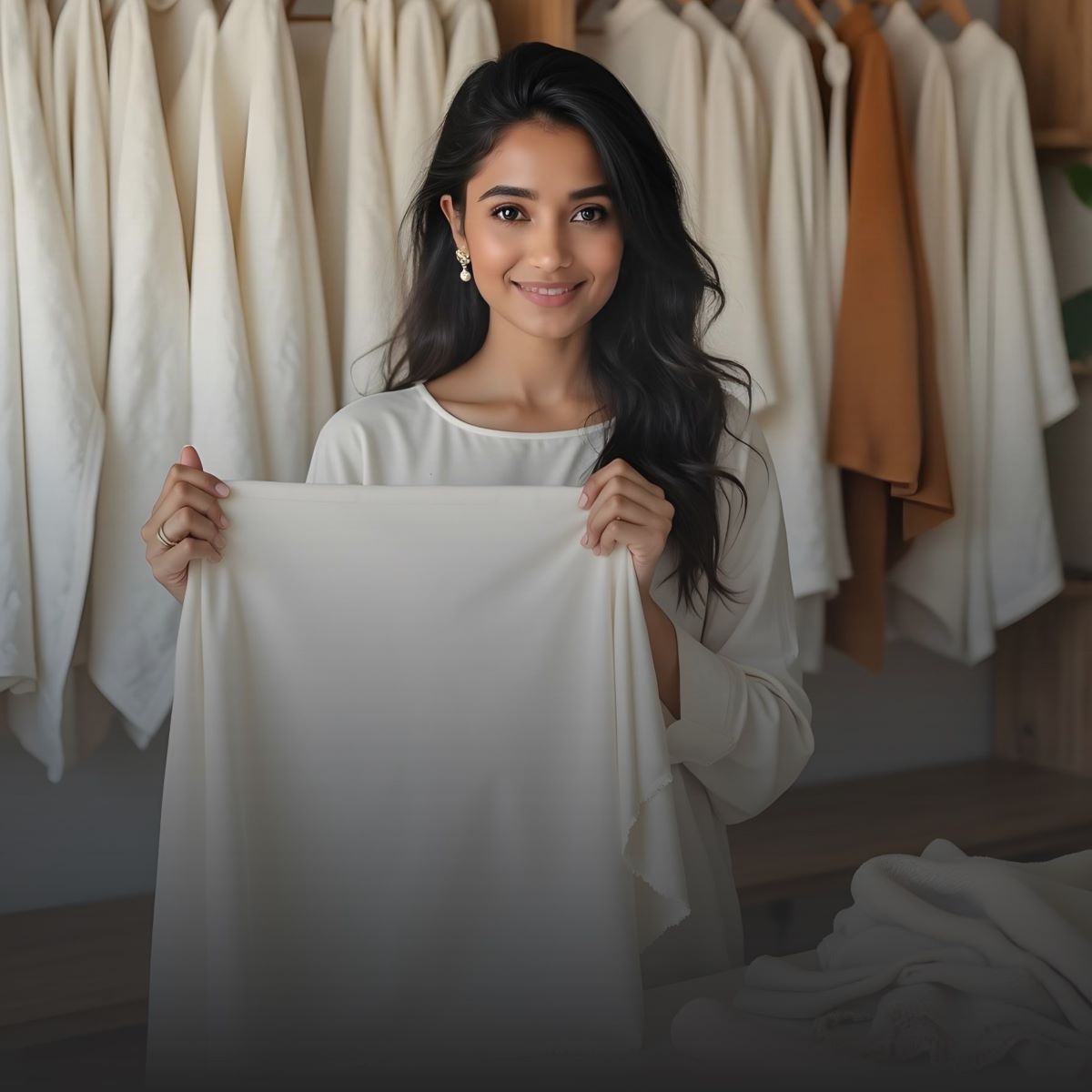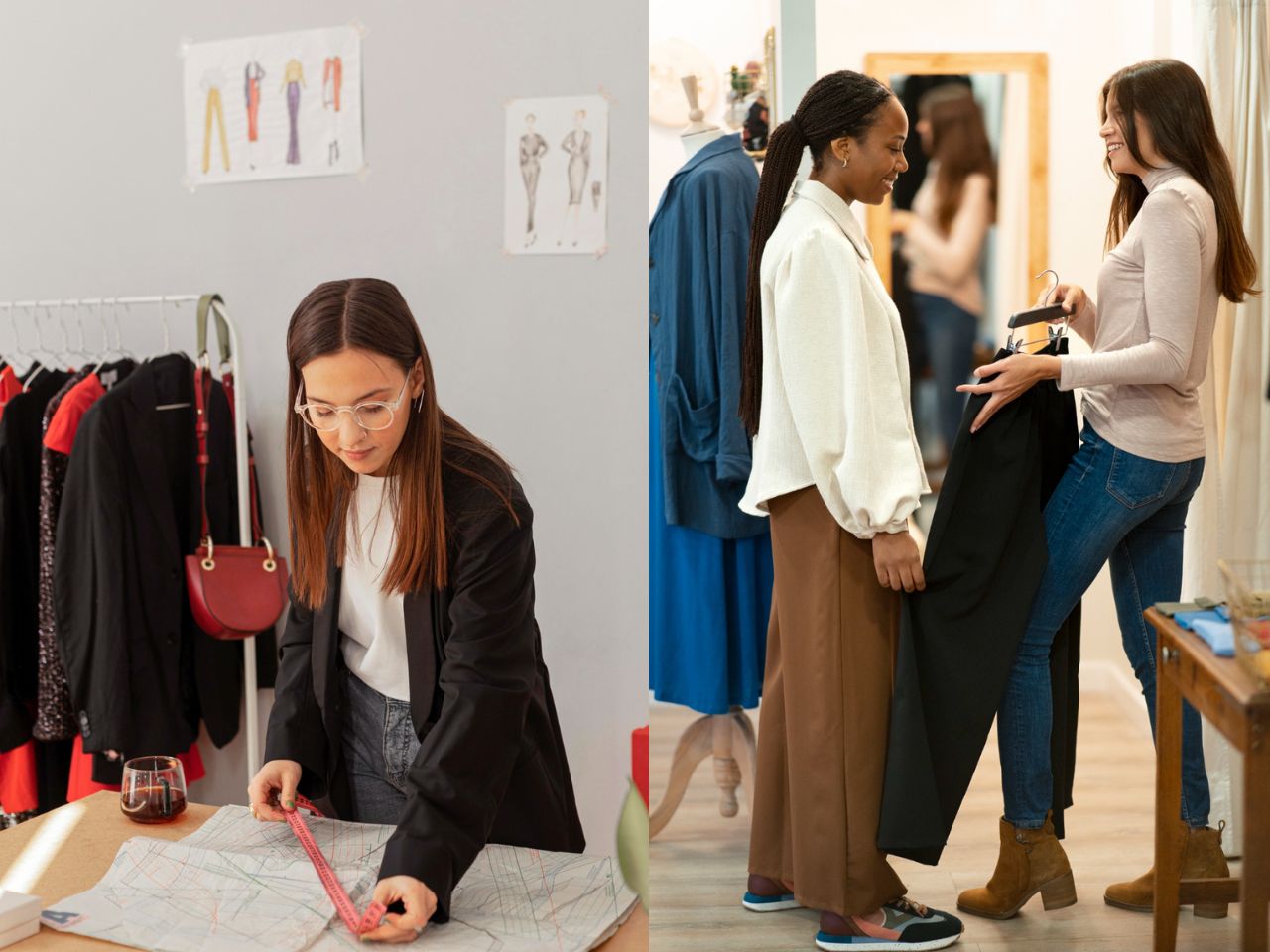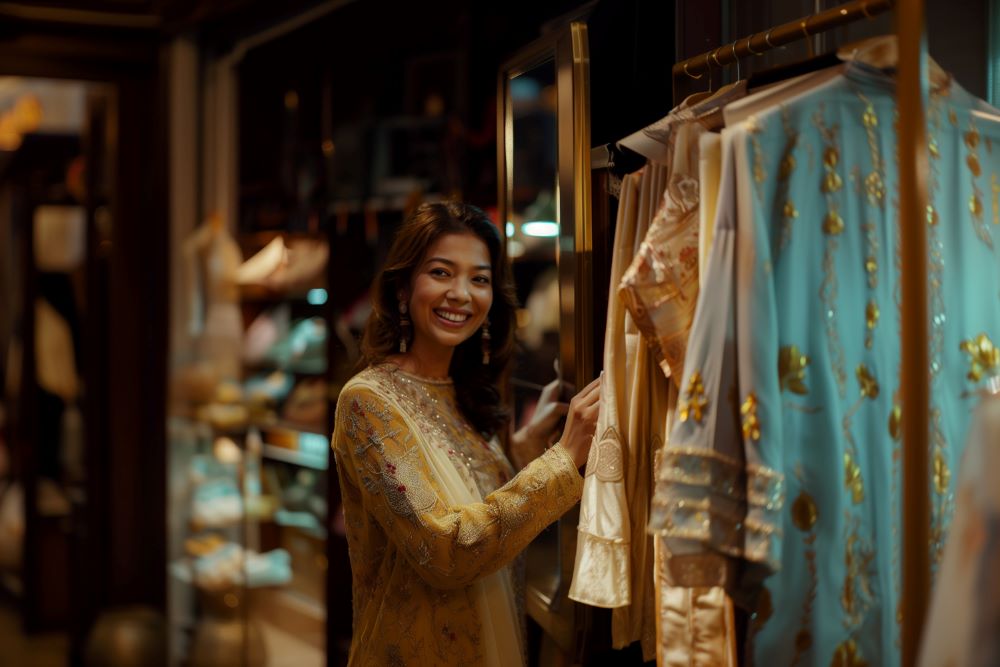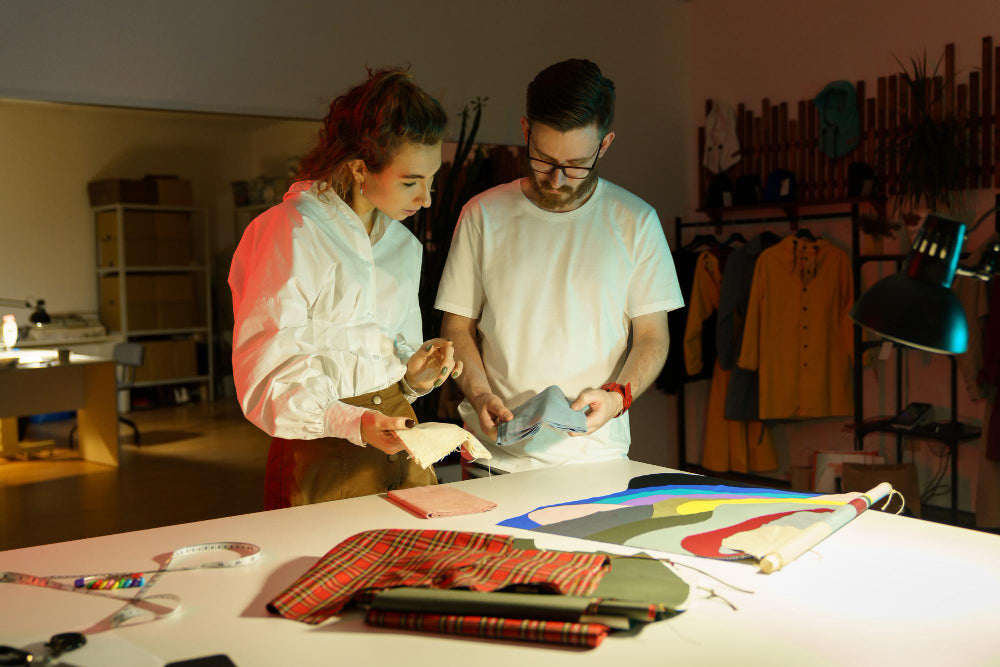Are you dreaming of launching your clothing brand? You're not alone. In the heart of fashion-forward cities like New York, Los Angeles, Miami, and Atlanta, emerging designers are turning ideas into successful brands, starting with a sketchbook and reaching a global audience. Whether you're eyeing a print-on-demand T-shirt business, custom wholesale apparel, or building a full-scale fashion label, tools and resources are at your fingertips today.
With Fabriclore — the best online fabric store for USA-based designers — you can easily get unique, high-quality fabrics with low MOQS, fast shipping, and design customisation.
This blog reveals the 10 essential steps to starting your clothing brand — from concept to customer — so you can begin to think smart, move fast, and design with purpose.
Read For More Related Information : How to Start a Successful Clothing Business in the United States (USA) in 2025
How to Start a Successful Clothing Brand: Step-by-Step Guide

Starting a clothing brand is fun and gratifying, but it takes planning, creativity, and strategy. Whether you love fashion design or want to start a profitable clothing brand, you must grasp brand building, market trends, and production procedures. In this step-by-step guide, we'll teach you how to design and grow your clothing business in the USA, from designing your first collection to marketing and growing your firm for long-term success in the competitive apparel sector.
01. Research And Choose Your Brand Strategy
Launching a successful clothing line requires more than just a great design idea. It starts with defining your brand's DNA. Here are some key components you should evaluate:
What is your mission?
Are you creating a sustainable fashion line, a bold streetwear brand or luxury loungewear?
Define your core values: sustainability, affordability, local craftsmanship or distinctive design?
Example: In cities like Portland and San Francisco, fashion entrepreneurs create slow fashion brands that prioritise environmental awareness and transparency.
What are the current fashion trends?
Stay updated on both global and local trends. In the U.S., there’s been a huge rise in:
- Sustainable and ethical fashion (widely seen in New York boutiques).
- Y2K revival styles, oversized silhouettes, and streetwear in Los Angeles.
- Athleisure and gender-fluid fashion in Chicago and Austin.
- Subscribe to platforms like WGSN or follow Pinterest Predicts for forecast reports.
True Insight: In Mugesa, Uganda, there is a belief that local designers take inspirational walks in their neighbourhoods, sparking ideas by observing nature, people, and textures. Although it sounds poetic, such practices are based on design thinking and are also seen in fashion capitals like New York, where designers take walks in Soho or Brooklyn for mood board material.
What makes you different (your USP)?
Ask: What is missing in the market that I can offer?
This could be:
- Size inclusivity
- Affordable but stylish workwear
- Machine-washable luxury (like silk)
Example: A Miami-based brand created machine-washable silk dresses that target women who want luxury without the dry-cleaning bill, solving a real problem.
Determine your niche
Defining your focus improves your marketing, design, and storytelling.
Niche areas could include:
- Small-size formalwear
- Gender-neutral urban clothing
- Tech-integrated activewear
Example: A start-up in Atlanta launched a plus-size streetwear line for Gen Z teens, combining cultural identity with size diversity.
Know your target audience
Build buyer personas by asking:
- Who are they (age, gender, lifestyle)?
- What are their daily struggles with clothing?
- Where do they shop, online or offline?
Example buyer persona:
Persona A: Millennial professionals in Seattle, ages 30-38, prefer earth-colored loungewear that’s both Zoom-appropriate and sustainable.
Persona B: College students in Los Angeles looking for trendy, customizable crop tops with affirming messaging.
Research competitors wisely
Analyse 3-5 top competitors in your area:
- What are their USPs?
- How do they approach pricing and promotions?
- What do their customer reviews say?
Tip: Use tools like SimilarWeb, SEMrush, and Instagram Insights to analyse their digital footprints.
Example: A t-shirt brand in Brooklyn found that its main competitor offered limited colour options, so they built their brand on colour variety and custom art collabs.
Write a mission statement
Once you’ve researched your area, target audience, and competitors, turn it into a clear mission. Your mission will shape:
- Your tone of voice
- Collection design
- Visual branding
- Marketing strategies
Bonus tip: Draw creative inspiration from your city
Many fashion creators practice visual journaling walks – a method in which they explore city streets to gain inspiration.
Mentioned in the book Fashion Thinking: Creative Approaches to the Design Process, this is a legitimate design method used by designers in New York and Paris.
Try it in your area – explore the fabric textures, cultural vibes, and streetwear styles that define your local community.
02. Create Your Brand Identity

Once your brand strategy is clear, it’s time to create a distinct and compelling brand identity – something your customers can recognise, trust and connect with. Here are four foundational pillars to do this effectively:
1. Product quality: Set the standard
Are you offering premium, mid-range or mass-market fashion?
Align product quality with your target audience’s expectations – a high-end silk shirt should feel luxurious in stitching, fabric and packaging.
Tip: In New York's Garment District, indie designers often shop for unique trims and fabrics to make their designs stand out, even on a low budget.
2. Pricing: Reflect your value
Price your clothing based on:
- Cost of fabric/material
- Manufacturing location (local vs. outsourced)
- Spending capacity of the target audience
- Competitive Pricing
Example: Sustainable brands like Everlane charge a premium for transparency and ethical sourcing.
3. Design and visual identity: Create a look they'll remember
Create a unified design language:
- Logo
- Colour
- Typography
- Packaging
- Website and social media aesthetics
- Your visual identity should match your product. Don’t design neon packaging for a muted, organic linen collection.
Use an AI-powered tool (e.g., Shopify Logo Maker or Looka) to get started quickly.
4. Brand name: Say a lot with your name
Choose a name that:
- Is easy to remember
- Reflects your brand’s character or uniqueness
- Works across different languages and cultures (important for expanding globally)
Tip: A brand like Reformation immediately suggests sustainability and style, ideal for a mission-driven fashion line.
Pro tip: Study successful brands
Create Pinterest boards or Notion pages for your favourite brands.
Analyse how brands like Glossier, Aritzia, or Fear of God express their mission through design, tone, and content.
Example: In Los Angeles, some designers walk Melrose Avenue or Abbot Kinney Boulevard to observe street fashion and gather real-time visual ideas — this approach is also mentioned on niche fashion blogs and in business interviews.
Craft a strong value proposition
Clearly state what makes your brand different:
- Ethical manufacturing
- Size inclusivity
- Signature silhouette
- Affordable luxury
Your value proposition becomes the bridge between your product and your audience's needs.
03. Decide Which Products To Sell
Once you've decided on your brand identity and defined your target market, it's time to determine which products will best convey your vision. Use your specific information to choose a product line that aligns with your values and your audience's needs.
What can you sell? Here are some proven ideas:
Sustainable wardrobe items
Essentials like tees, tank tops, and joggers are made from a blend of organic cotton, Tencel, or bamboo.
Custom bridal or bridesmaid gowns
It is ideal for luxury or occasion wear, especially if you want to specialise in personalisation.
Embellished wholesale pieces
Buy wholesale basics like sweaters or jackets and customise them with hand embroidery, beadwork, or prints.
Print-on-demand t-shirt business
Low overhead, trendy, and scalable. Tools like Printful or Printify can help you get started quickly.
Seasonal dropshipping
To avoid inventory risks, cold-weather accessories like gloves, scarves, and beanies are best sourced through dropshipping platforms.
Pet-lover personalisation niche
Let customers print photos or sketches of their pets on caps, tees, or mugs. Great for gift-giving markets.
Artisan accessories
Hand-stitched scarves, hand-dyed stoles, or upcycled denim bags are especially effective for a slower-paced audience.
Athleisure wear
An ever-growing market. Focus on comfort, fit, and breathable fabrics like modal, cotton-spandex blends, or recycled poly.
Hand-painted loungewear
Unique and Instagrammable — think robes, pyjamas, and kimono sets with custom brushstroke art.
Define the style of your product
The style of your product should reflect your brand personality. Ask: How do I want customers to feel when they wear my designs? Some popular style directions:
- Classic cuts that have stood the test of time and neutral colours.
- Modern - minimalist or monochrome.
- Preppy - polished, collegiate.
- Casual - oversized, lounge-forward.
- Sporty - athleisure, performance-based.
- Gothic Dark tones, sharp silhouettes.
- Unique or fun - bright colours, ironic slogans, playful prints.
Don't forget the fabric choice
The fabric you select is equally important as the style - it's the essence that defines your company. Examples:
- Cashmere luxury knits, silk-cotton blends, wool blends.
- Eco-friendly fabrics – organic cotton, hemp, recycled polyester, cupro.
- Cost-effective options – standard cotton, rayon, and poly blends for a wider reach.
Start small, test, and scale
Especially if you're making your apparel:
- Start with 1-5 hero products – a best-selling hoodie, a signature dress, or your best-fitting t-shirt.
- Confirm demand before expanding your range.
- Keep prototyping and sampling costs manageable.
If you manufacture your products instead of employing a drop shipper, start small. Design a few things (or one) to begin with, and then continue. Do not take on too much.
04. Choose A Business Model & Register Your Business

When starting a clothing business, pick a model that fits your goals and resources:
- Private Label: Design your clothing and have it manufactured. You control quality, fabrics, and style, but you'll manage inventory and upfront costs.
- Custom Wholesale: Buy wholesale garments and customise them by hand. It's unique but labour-intensive and needs space.
- Custom Clothing: Offer made-to-order outfits, such as bridal gowns or branded uniforms. It's personal and high-end but harder to scale.
- Dropshipping: Sell curated products from suppliers who ship directly to your customers. It's low-cost but gives you less control.
- Print on Demand: Add your designs to items like t-shirts or hoodies. The print partner handles production and shipping. It's low-risk and great for graphic products.
Once you've picked your model, register your business. Choose a structure, such as a sole proprietorship, LLC, or corporation. Apply for an EIN (Employer Identification Number) to handle taxes. Consult an attorney or your local chamber of commerce for guidance if unsure.
05. Connect With Reliable Partners

Finding reliable partners, such as a fabric supplier, manufacturer, or packaging vendor, is crucial to building your clothing line. You need trusted professionals if your business relies on timely, quality materials.
If you're a new brand, be prepared to clearly explain your vision and understand your partner's production process. How do you assess potential partners?
- Check online reviews.
- Request product samples.
- Request suggestions.
- Utilise social media platforms to get feedback.
- Find out about previous projects.
- Please request an appointment to tour their office or video chat.
Looking for a trusted wholesale fabric supplier in the USA to scale your clothing business? Explore Fabriclore's vast fabric range and customized sourcing services—get started today.
06. Review Costs And Business Expenses

Before you start, map out your expenses. This helps in budgeting, tracking costs, and securing funding if needed. Starting a clothing business requires investment, but with the right plan, it can be profitable.
Every day, start-up expenses include:
- Design: Hiring a designer, purchasing design software, or purchasing materials.
- Manufacturing: Cost to create and produce samples (larger orders = lower per-unit cost).
- Inventory and storage: If not dropshipping, you'll need storage space and inventory management tools.
- Packaging: Custom boxes, branded tags, and tissue paper for a premium unboxing experience.
- Shipping: Inbound shipping (to you) and outbound (to customers), price in your final product.
- Legal: Contracts and agreements should be reviewed by an attorney — budget for legal fees.
- Licenses and permits: Business registration varies by state — research your local requirements.
- Website: Hosting, domain, ecommerce platform, photography, and any design or SEO help.
- Marketing: Paid ads, influencers, affiliate marketing, and referral programs.
- Taxes: Talk to an accountant to plan for quarterly or annual tax payments.
Calculate these costs ahead of time. Calculation planning helps you build a strong foundation for your clothing brand.
07. Start Building Your Online Clothing Store

Once your brand identity is ready, building your online store takes time. Choose an ecommerce platform like Shopify, Wix, or WooCommerce that offers templates, customisation options, and robust selling tools. Key elements to include on your site:
- Homepage: Showcase your main products and a clear, one-line tagline articulating your value. If you haven't launched yet, build an email list with a "coming soon” page and a subscription form.
- About us: Share your story, mission, and what makes your brand different. This helps build trust and authenticity.
- Product pages: Include detailed descriptions, sizing information, material and care instructions, high-quality images, and customer reviews.
- Customer support page: Clearly outline return policies, shipping times, and frequently asked questions. Also, provide contact options for personalised support.
- Easy checkout: To reduce abandoned carts, smooth the process, and offer secure, fast payment options like PayPal and Apple Pay.
08. Write A Business Plan

A business's plan of action is your guideline. It can help you define the goals of your business and guide how you can grow your business.
What should be included:
- Description of the company: The name of the company, its mission statement, the background information, items, and long-term objectives.
- Products: Explain each item, including pricing and cost, and provide the date it will be made available.
- Market analysis: Describe industry trends, competition, and the target market. Define how you'll fit into the market and what you can do to make a mark.
- Marketing and operations: Outline your brand identity, business model, and promotional strategy.
- Structure and management: The first step is to define your team, even if it's just yourself, and then make plans for possibly hiring partners or employees in the future.
- Forecasts of financials: Describe the start-up cost, the funding requirements, and when you plan to make profits.
- Appendices: Include essential documents, like contracts, licenses, or drawings, to adapt the strategy.
09. Design And Build Prototypes

Today is the time for you to put your dream to life with the help of the design of your product and sample.
Begin by sketching
Begin by sketching out your concepts on paper or using a computer. If you're creating an outfit, hoodie or accessories, a visual map is crucial.
Build prototypes
You have two options:
- DIY prototypes: If you have sewing skills and equipment, create initial samples yourself.
- Professional help: Hire a designer or work with a manufacturer who can create prototypes for you.
If outsourcing, provide a tech pack that includes:
- Fabric details
- Measurements
- Stitching and finishing
- Labels and tags
- Packaging instructions
- Sample quality is everything
Before ordering large quantities:
- Check the quality, comfort, and durability of your samples.
- Wash and wear-test the garments to assess shrinkage, colour fastness, and overall wear.
- Make sure the end result is in line with your vision and brand quality.
If you're using print-on-demand or dropshipping, always order a few test products to inspect the actual items before listing them in your store.
IMPORTANT: If you're selling a wide range of clothing — for example, denim and knits — you may need to work with multiple manufacturers specialising in each.
Once confident in your designs and quality, you can place production orders and prepare for launch!
10. Start Your Marketing Campaign

Your products are ready – now it’s time to tell the world about them. A solid marketing plan is essential to draw people’s attention to your brand and boost those first sales.
Start with a strategic marketing plan
Your marketing plan should include:
- Define your target audience
- Highlight your unique selling proposition (USP)
- Outline what platforms and strategies you’ll use to attract, convert, and retain customers
Key marketing channels for clothing brands
1. Search engine optimisation (SEO)
- Optimising your site helps increase organic traffic over time.
- Research data shows that stores that complete their SEO setup get twice as many visitors and 1.3 times more revenue.
- Focus on keywords related to your niche, like “boho cotton dresses” or “sustainable streetwear for men.”
2. Organic Social Media Marketing
- Choose platforms where your audience spends their time (e.g., Instagram for fashion, Pinterest for aesthetics).
- Create branded profiles and post engaging content:
- Peeks behind the scenes
- Style tips
- Details of product sales
- Customer testimonials
3. Pay-Per-Click (PPC) Advertising
- Platforms like Facebook and Google Ads help you generate instant visibility.
- With the Facebook Ads tool, some store owners have achieved over 1,000% return on ad spend.
- Start small, test creatives and refine them based on performance.
4. Multi-Channel Selling
Don’t limit yourself to one platform:
- Set up Facebook and Instagram shops.
- List on Amazon, eBay or Etsy.
- Brands that integrate just one additional channel see sales growth of up to 12%.
5. Influencer Marketing
- Work with fashion influencers who resonate with your brand values and audience.
- Even micro-influencers with niche followings can foster strong engagement and trust.
6. Brand Ambassador Programs
- Inspire faithful customers to turn into fans.
- Provide incentives such as discounted prices or access to early in exchange for shares, reviews or referrals.
7. Strategic Partnerships
- Collaboration with other brands with the same demographic.
- Ideas for HTML0 include co-hosted giveaways, swapping of content, or bundle promotional offers.
8. Content Marketing
- Bring value to your site through blog posts, styling videos, styling ideas, or behind-the-scenes videos.
- They can help build credibility, increase SEO, and strengthen relationships with customers.
Pro Tip:
Start small and keep track of your progress. Choose one or two marketing channels initially and expand later as you progress and discover which ones work best for your target audience.
Read For More Related Information : How to Build an Online Clothing Business Store in the USA
Why Start A Clothing Business?

Starting a clothing business can be both creatively gratifying and financially rewarding. Here's why it's worth considering:
- Creative expression: If you love fashion, this is a great way to turn your passion into a profession by designing styles and setting trends.
- Entrepreneurial freedom: It offers the chance to be your own boss, with opportunities in design, production and retail.
- Diverse markets: With niche markets such as casual wear, activewear and sustainable fashion, there's room to find your unique niche.
- Trend capitalisation: If you keep an eye on trends, you can stay ahead and attract an audience that loves style.
- Online growth: The global online clothing market is growing rapidly, expected to reach $160 billion in the US by 2025.
- Brand building: Launching a brand builds identity, increases customer loyalty and opens the door for customisation.
- Global reach: E-commerce allows access to international customers – global clothing revenue is projected to reach $770 billion in 2024.
Challenges To Consider

Running a clothing business poses many obstacles:
- Sustainability concerns: Excessive water use, pollution, and textile waste make environmental impact a growing problem.
- Supply chain dependencies: Global disruptions (e.g., war, natural disasters) can delay deliveries and increase costs.
- Rising costs: Raw materials, labor, and environmentally friendly practices all impact profitability.
- Market uncertainty: Fashion trends change rapidly, and economic downturns can lead to spending cuts or pricing pressure.
Conclusion
In this blog, we explored how to design and grow a successful clothing business in the USA - from conceptualising your brand to choosing the proper sales channels. One of the most critical factors in creating a scalable fashion label is finding trustworthy fabric material suppliers and fabric wholesalers who understand your product requirements and deliver consistent quality. Especially in competitive markets like Los Angeles and New York, sourcing from the right partners ensures both efficiency and uniqueness in your designs. If you're looking for a reliable fabric supplier in the USA, Fabriclore can help you streamline your sourcing journey. For new and expanding brands, we provide low MOQ alternatives, design flexibility, and access to a large selection of premium fabrics. We're here to help you bring your idea to life, whether you sell in person or online.
Find More
How to Start a Successful Clothing Business in the United States (USA) in 2025How to Source Fashion Fabric for Your Clothing Business in the USA
How To Set Up Production And Manufacturing For Your Clothing Business Line In The USA
How To Build Pricing And Inventory For Your Clothing Line Business In The USA?
How To Plan Your Collection Around The Fashion Season In The USA
How to Build an Online Clothing Business Store in the USA
How to Market Your Clothing Business Online in the USA
How To Use AI To Predict Fashion Trends For Your Clothing Business In The USA
FAQs
1. What are the initial costs to start a clothing business in the USA?
- Budget between $2,000 to $10,000 to start a small to mid-sized brand.
- Covers website, branding, product development, and inventory.
Starting online is more cost-effective, while launching in cities like New York or Los Angeles can increase setup costs due to rent and permits.
2. How profitable is a clothing business in the USA?
- High potential if you have a clear niche and effective branding.
- Demand exists for both fashion-forward and sustainable pieces.
With a strong identity and marketing strategy, many clothing startups achieve solid margins even in competitive spaces.
3. How can I start a clothing brand in cities like New York or Los Angeles?
- Begin by studying the local market and connecting with fabric wholesale manufacturers.
- Leverage industry events and fashion communities to network.
These cities offer access to top-tier fabric wholesalers and a trend-savvy customer base—ideal for launching bold, creative lines.
4. Is it necessary to form an LLC for a clothing brand?
- Not required but highly recommended for liability protection.
- Helps build trust with textile suppliers and vendors.
An LLC gives your business a professional edge and safeguards your personal finances, especially important as your operations grow.
5. What are the best ways to sell clothing in the USA?
- Start with an online store, then expand to wholesale fabric vendors, pop-up shops, or retail outlets.
- Use platforms like Shopify, Amazon, or Etsy to test products.
A multi-channel approach helps build visibility and reach, especially in metro areas like Chicago, Miami, and San Francisco.
We also happen to be a magnet for suggestions, and would love to catch yours….throw us yours on hello@fabriclore.com
